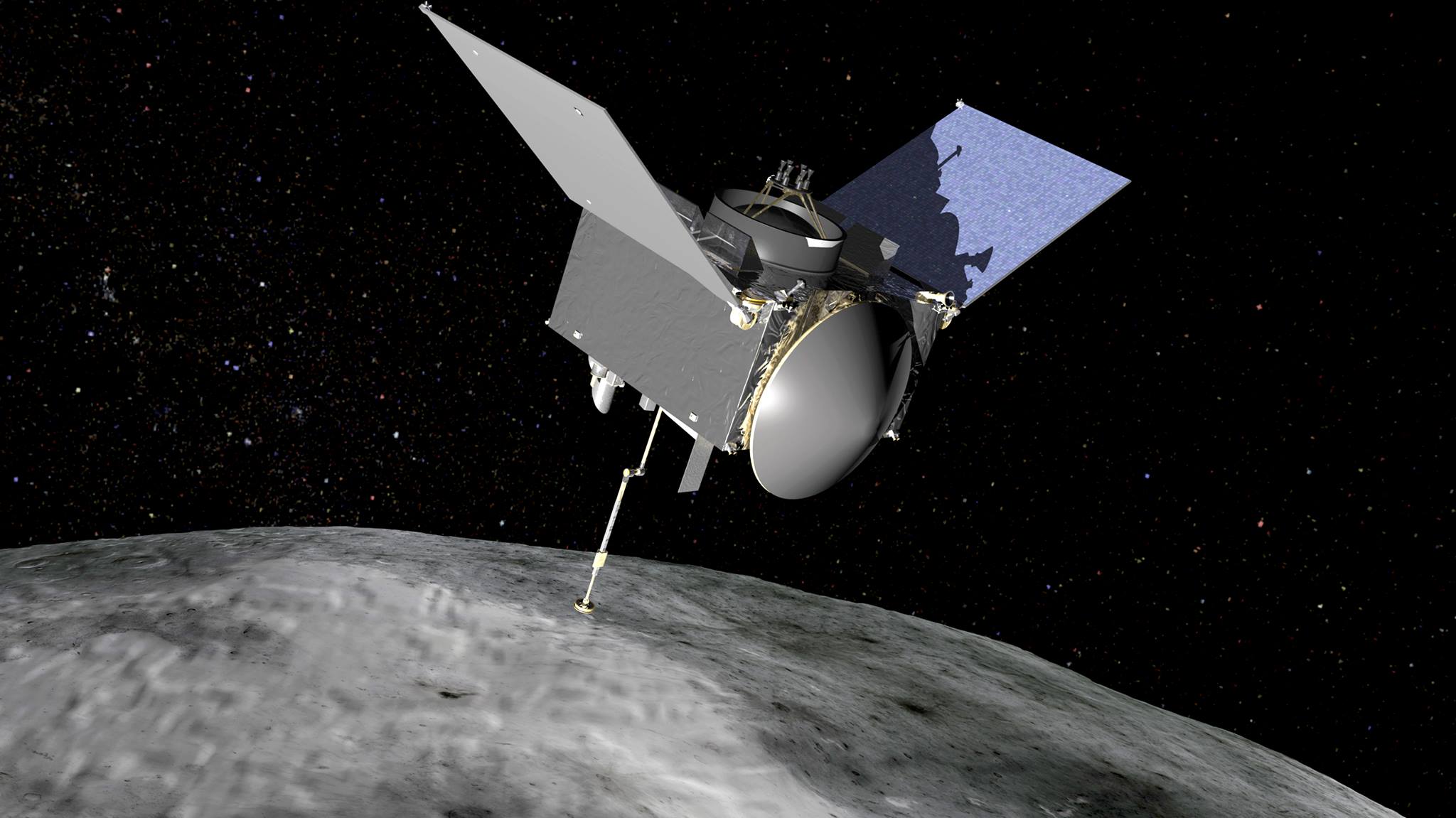
Tomorrow evening, if all goes well, a spacecraft destined to visit, retrieve, and return samples from a near-pristine “carbonaceous” asteroid will roar aloft atop a unique “flying-sideways” rocket from Cape Canaveral Air Force Station, Fla. NASA’s $800 million Origins, Spectral Interpretation, Resource Identification, Security, Regolith Explorer (OSIRIS-REx) spacecraft represents the third member of the New Frontiers program—a medium-class series of deep-space exploration missions, following hard on the heels of New Horizons to Pluto and Juno to Jupiter—and is truly audacious in its scope.
As outlined in yesterday’s AmericaSpace article, OSIRIS-REx will spent the next two years traveling to the near-Earth asteroid (101955) Bennu. From August 2018 onward, it will spend 505 days extensively mapping this virtually untouched remnant from the dawn of the Solar System’s 4.5-billion-year lifespan, before selecting a location to descend and take a sample. At some point in July 2020, the spacecraft’s 11-foot-long (3.35-meter) articulated arm and sample collector head will gather between 2 ounces (60 grams) and 4.4 pounds (2 kg) of regolith from Bennu’s carbon-rich surface. And three years after that, the Sample Return Canister (SRC) will bring those priceless extraterrestrial grains to an expectant scientific community back on Earth.
Last week, encapsulated within its 14-foot-diameter (4-meter) Large Payload Fairing (LPF), OSIRIS-REx was transported to Space Launch Complex (SLC)-41 at the Cape and installed atop its United Launch Alliance (ULA) Atlas V booster. Although the highly reliable Atlas V has been flown on 64 occasions since August 2002, tomorrow’s flight will be only its fourth mission in the “411” configuration. Numerically designated to describe a 14-foot-wide (4-meter) payload fairing, a single strap-on, solid-fueled booster, and a single-engine Centaur upper stage, the 411 was first used to deliver the Astra-1KR communications satellite to Geostationary Transfer Orbit (GTO) in April 2006. More recently, the NROL-28 and NROL-34 payloads were lofted atop 411s for the National Reconnaissance Office in March 2008 and April 2011, respectively.
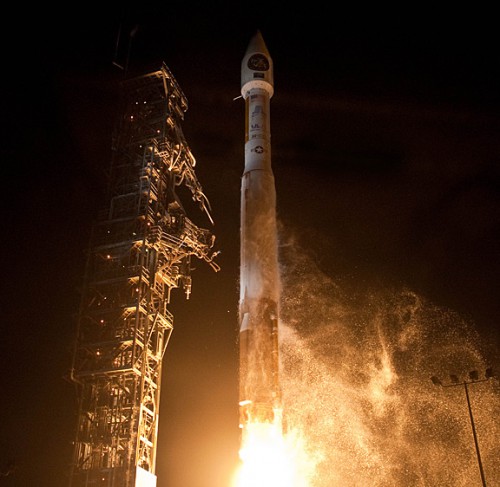
This particular configuration can transport up to 26,530 pounds (12,030 kg) into low-Earth orbit and up to 13,110 pounds (5,950 kg) into GTO and is ideally suited to deliver the 3,371-pound (1,529 kg) OSIRIS-REx onto a trajectory which will see it depart the Earth’s gravitational “well” and head into deep space. Processing of the launch vehicle has been ongoing since early August, when the 106.5-foot-tall (32.5-meter) Common Core Booster (CCB)—boasting a dual-nozzle RD-180 engine, fueled with liquid oxygen and rocket-grade kerosene (RP-1)—was hoisted aloft in the Vertical Integration Facility (VIF) at SLC-41. Over the next few days, the 55.7-foot-long (17-meter) solid-fueled booster was attached, followed by the 41.5-foot-long (12.6-meter) Centaur upper stage.
With the spacecraft atop the booster, the Atlas V 411 presently stands an impressive 189 feet (57.6 meters) tall. A standard Integrated Systems Test and Flight Readiness Review (FRR) were concluded last week, with the Launch Readiness Review (LRR) wrapped up yesterday (Tuesday). The vehicle was then due to roll, atop the Mobile Launch Platform (MLP), a distance of a half-mile (400 meters), from the VIF to the SLC-41 pad surface on Wednesday, 6 September. Once there, it was carefully centered and propellant umbilicals and electrical and data connections were established with the Ground Support Equipment (GSE). The track mobiles from the MLP were removed and efforts set in motion to begin formal countdown operations.
Although the CCB’s supply of RP-1 is “storable” and loaded a few days beforehand, the liquid oxygen tanking will occur relatively late in Thursday’s countdown, in order that the boiled-off cryogens can be continuously replenished until close to T-0. In tandem, liquid oxygen and hydrogen will be loaded aboard the Centaur, whose RL-10A-4-2 engine— capable of 22,330 pounds (10,128 kg) of thrust—will execute two “burns” to set OSIRIS-REx on its way to Bennu. A final “Go/No-Go” poll of all stations, led by the ULA Launch Conductor, will permit teams to press ahead into the Terminal Countdown and the clock will be released from its final, pre-planned hold at T-4 minutes.
Thursday’s launch window extends for two hours, opening at 7:05 p.m. EDT, about a half-hour before local sunset. According to the 45th Weather Squadron at Patrick Air Force Base, there exists a 70-percent likelihood of acceptable weather conditions for the primary launch attempt and the two backup opportunities on Friday and Saturday evenings. Key concerns center around a tropical wave in the Caribbean Sea on Thursday, possibly leading to showers and isolated thunderstorms over Central Florida. “The sea breeze will develop late morning and migrate inland early afternoon with showers and isolated thunderstorms,” noted the 45th, in its L-3 weather update on Monday afternoon. “Afternoon and evening thunderstorms continue to favor the interior with a coastal shower threat during the evening and overnight hours.” The primary violating factors on Thursday, Friday, and Saturday’s launch attempts are expected to be Cumulus Clouds and Anvil Clouds.
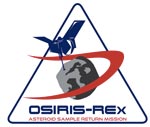
A final “Go/No-Go” poll of all stations, led by the ULA Launch Conductor, allowed teams to press ahead into the Terminal Countdown and the clock was released from its final, pre-planned hold at T-4 minutes at 7:01 p.m. During these final minutes, all propellant tanks aboard the Atlas V will be pressurized and the Flight Termination System (FTS)—tasked with destroying the vehicle in the event of a major contingency during ascent—will be placed onto internal power and armed.
The Russian-heritage RD-180 engine, with a total propulsive yield of 860,000 pounds (390,000 kg), will ignite at T-2.7 seconds and ramp up to full power, before the vehicle is released from the pad at T+1.1 seconds. As with the 64 Atlas Vs which flew before it, Thursday’s rocket will ascend vertically, although the peculiarly asymmetrical 411 configuration will lend an unusual perspective for spectators along the shores of the Space Coast. With just a single strap-on booster, the exhaust plume will appear to veer off to one side—a disconcerting view to the first-time observer.
A little under seven seconds into the flight, the avionics aboard the Centaur will command a pitch, roll, and yaw program maneuver, establishing the booster onto its proper flight azimuth of 89.0 degrees. The strap-on booster will be jettisoned at 139 seconds, whilst the RD-180 will continue to burn hot and hard until Booster Engine Cutoff (BECO) shortly after the four-minute mark. The CCB and Centaur/OSIRIS-REx stack will then part company. The upper stage’s restartable RL-10-4-2 engine will roar to life for its first “burn” at four minutes and 18 seconds, firing for a little more than eight minutes. During this period, the LPF will be discarded, exposing OSIRIS-REx to the space environment for the first time. Shutting down, the Centaur and its precious payload will coast for 21.5 minutes, before its engine ignites a second time. On this occasion, it will burn for just under seven minutes and, following its second shutdown, OSIRIS-REx will be released at 55 minutes into the mission.
Thus will begin the long journey to Bennu. It is a journey that will carry OSIRIS-REx no less than 509 million miles (819 million km), relative to Earth, in order to reach the asteroid, which clips around the Sun at 61,300 mph (98,650 km/h).
Initially, the spacecraft will enter solar orbit, performing a flyby of Earth in September 2017 to accrue a gravitational push and increase its velocity by 1,200 mph (1,930 km/h). This will create the proper conditions to rendezvous with its asteroid quarry in August of the following year. Using its on-board hydrazine fuel supply, OSIRIS-REx will maneuver around Bennu and conduct reconnaissance flyovers at an altitude of about 800 feet (240 meters) from its dusty surface. Over the next 505 days—from August 2018 through spring 2020—its five instruments will globally map the asteroid’s surface using optical and multispectral sensors and a laser altimeter from a mean distance of 3.1 miles (5 km).
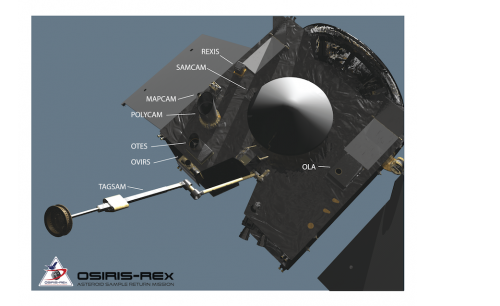
During the course of this extensive mapping phase, prime locations will be considered to gather a surface sample. Current plans call for around a dozen potential sites to be identified and later winnowed down to two finalists, from which the final sampling location will be selected. After performing several close-range reconnaissance flybys and rehearsals, the actual sample collection is targeted for July 2020.
In order to prepare for this event, OSIRIS-REx’s twin solar arrays will be raised into a “Y-wing” configuration, in order to minimize the risk of dust accumulation during contact and provide better ground clearance in case the spacecraft tips. Taking center-stage, however, will be Lockheed Martin’s Touch-and-Go Sample Acquisition Mechanism (TAGSAM). This 11-foot-long (3.35-meter) articulated arm and sampler head is tasked with actually gathering a specimen from Bennu’s surface and returning it to Earth. OSIRIS-REx will maneuver slowly towards the target site at a velocity of about 0.6 feet per second (0.2 meters per second), with the entire process documented by the spacecraft’s on-board instruments. The rate of descent toward Bennu is carefully controlled to restrict the use of the hydrazine thrusters and limit the possibility of contaminating the asteroid’s pristine carbonaceous surface.
An on-board supply of three gas “bottles” will provide the capability to “fluidize” the regolith with an annular jet of nitrogen, agitating the soil and allowing it to removed quickly—within about five seconds—via a bulk sampling mechanism and soft surface-contact pads, directly into the sampler head. The five-second time limit has been imposed in order to limit the risk of OSIRIS-REx colliding with Bennu; when the timer expires, a back-away maneuver will be initiated to ensure a safe separation distance, prior to another sampling attempt. When the task is completed, the TAGSAM will place the sampler head and surface-contact pad directly into the Sample Return Canister (SRC), which will be closed and severed from the articulated arm.
OSIRIS-REx’s departure from Bennu is targeted for March 2021, with the return to Earth expected on 24 September 2023. The SRC will separate from the spacecraft and re-enter the atmosphere at more than 27,000 mph (43,000 km/h), guarded from the temperature extremes by an ablative heat shield and protective aeroshell. This will be the second-fastest human-made object in history, pipped slightly by the Stardust sample-return capsule, which attained 28,185 mph (45,360 km/h) during its re-entry in January 2006, bearing particles from Comet Wild 2.
High above the Utah Test and Training Range (UTTR) in Tooele County, Utah, a drogue parachute will be deployed to provide stability at supersonic speeds, followed by a main canopy, all of which will slow the descending SRC to a landing rate of about 11 mph (18 km/h). Seven years to the month since its launch, a small segment of OSIRIS-REx will thus return to Earth with the largest collection of extraterrestrial material ever returned from another heavenly body since the Apollo era. Relative to Earth, the mission will have traveled around 4.4 billion miles (7.1 billion km) since launch. The analysis process will begin immediately, with the samples from Bennu transported to the Astromaterials Acquisition and Curation Office at the Johnson Space Center (JSC) in Houston, Texas.
Want to keep up-to-date with all things space? Be sure to “Like” AmericaSpace on Facebook and follow us on Twitter: @AmericaSpace
Missions » OSIRIS-REx »




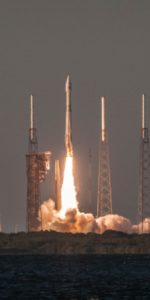
Well,
Now that this has launched we can be so happy that our Tax Dollars are doing important works in underwriting the space mining industry R&D budgets. Considering a casual glimpse of the Clinton/Email/Foundation/Pay-For-Play reality that exists perhaps this can’t come soon enough as we struggle with resource sharing on Earth or the lack there of. Certainly we all understand the peril of continued consolidation of the marketplace by the elites…Well maybe we don’t..still existing operators are watching closely see below.
http://qz.com/776894/nasas-latest-mission-will-show-if-asteroid-mining-will-be-a-real-threat-to-the-global-platinum-industry/
Tracy the Troll –
“Space miners will first target water-rich asteroids for their hydrogen potential, then mineral-rich asteroids for their nickel and iron-ore.”
And, “But asteroid miners aren’t planning to compete with the earth market, says Charles Kieck, head of energy and precious metals at Afriforesight, a commodities research firm in Cape Town. Thanks to 3D printing, the aim is to use asteroid materials in space to produce equipment and spare parts for crafts going even further.”
From: ‘NASA’s latest mission will show if asteroid mining will be a real threat to the global platinum industry’ By Lynsey Chutel September 09, 2016
At: http://qz.com/776894/nasas-latest-mission-will-show-if-asteroid-mining-will-be-a-real-threat-to-the-global-platinum-industry/
The quotes remind me of a book I read as a kid – ‘Islands in Space: The Challenge of the Planetoids’ by Dandridge Cole and Donald W. Cox 1964. It is a great book!
Eventually, we’ll build massive Islands in Space that will remain in orbit around our Sun and planets or head off toward distant stars. However, Galactic Cosmic Radiation will always be an important issue. See: ‘Interstellar ark’ at Wikipedia
Note also: “The radiation environment of deep space is very different from that on the Earth’s surface, or in low earth orbit, due to the much larger flux of high-energy galactic cosmic rays (GCRs) along with radiation from solar proton events and the radiation belts. Like other ionizing radiation high-energy cosmic rays can damage DNA, increase the risk of cancer, cataracts, neurological disorders, and non-cancer mortality risks.[8]”
From: ‘Generation ship’ at: Wikipedia
Iron seems to be optimum for shielding against Galactic Cosmic Radiation.
“Iron proves to be optimum better material than lead since it has a lower rate of secondary neutron production. Figure 39 shows the total neutron outbound flux in the energy range of interest for all the materials considered in this analysis. For a given thickness, iron outperforms lead by a factor of 5 and hydrogenous materials on average by a factor of 20, making it the shielding material of choice for neutrons above 20 MeV.” Page 76
From: ‘Cosmic Ray Interactions in Shielding Materials PNNL-20693 Prepared for the U.S. Department of Energy under Contract DE-AC05-76RL01830’ By E Aguayo, RT Kouzes, AS Ankney, JL Orrell, TJ Berguson, and MD Troy July 2011
At: http://www.pnnl.gov/main/publications/external/technical_reports/PNNL-20693.pdf
If we are really serious about colonies on the Moon, Mars, Ceres, and in many other locations and in orbits beyond LEO, maybe we’ll mine lots of “iron-ore” in space.